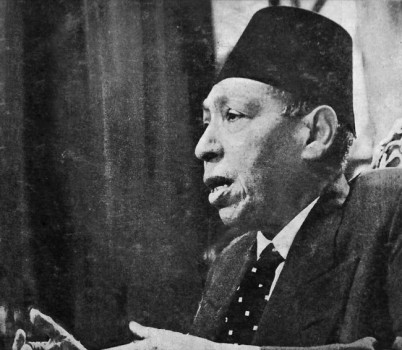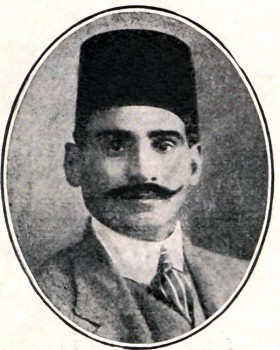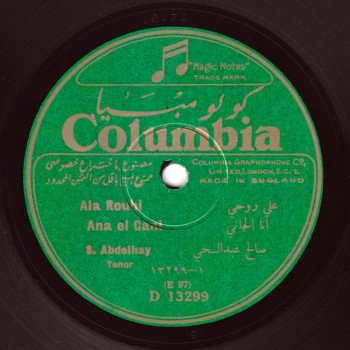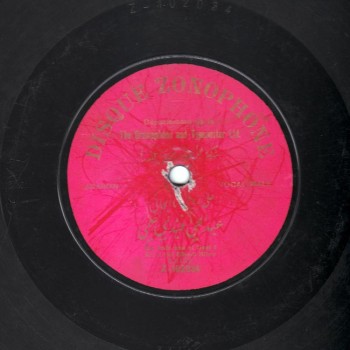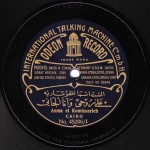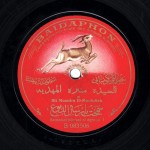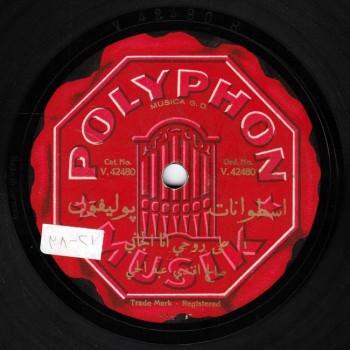 The Arab Music Archiving and Research foundation (AMAR), in collaboration with the Sharjah Art Foundation (SAF), presents “Sama‘ ”.
The Arab Music Archiving and Research foundation (AMAR), in collaboration with the Sharjah Art Foundation (SAF), presents “Sama‘ ”.
“Sama‘ ” discusses our musical heritage through comparison and analysis…
A concept by Mustafa Said.
Dear listeners,
Welcome to a new episode of “Sama‘ ”.
Today’s episode is very simple since we will be discussing a simple piece with simple lyrics, tunes, and whose performance must be simple. A complex interpretation of this work, in my opinion, would not satisfy the listeners.
The piece is dawr “ ‘Ala rōḥī anā el-gānī” whose author is unknown, and whose melodic form goes back to the period before Muḥammad ‘Abd al-Raḥīm al-Maslūb’s that in turn precedes ‘Abduh al-Ḥāmūlī and Muḥammad ‘Uthmān’s period that witnessed a significant evolution of the dawr form. This dawr may thus date back to the 18th century, knowing that the melodies that reached us from this period and from before this period are mostly the melodies of muwashshaḥ, added to earlier forms including the basīṭ and the qawl… But let us focus on the more modern melodies, i.e. the muwashshaḥ.
I said that this piece is one of the rare dawr that have reached us because the characteristics of the muwashshaḥ form are usually known/fixed:
– Its either simple or compound maqām must be known, i.e. well-defined in the composer’s mind, whether it is the initial maqām or a sub-maqām;
– The rhythm may also be either a simple or a compound rhythm.
So, creating this piece required artistry and skill, unlike the dawr preceding ‘Abd al-Raḥīm al-Maslūb that were infinitely simple, and intersected with ṭaqṭūqa. Some attribute ṭaqṭūqa to the female singing repertoire and dawr to the male singing repertoire.
The form is the same for both: they both include some dialogue, but dawr allow more improvisation in the melody than ṭaqṭūqa.
In some books, this dawr is categorized as a rāst, whereas in other books, it is categorized as a jahārjāh. I agree with the latter, even though I am not fully convinced… we will learn why later in our episode.
This episode includes 7 recordings of this dawr:
- The oldest recording is of the great muṭriba Sitt Asma al-Kumthariyya, known for singing dawr unlike the other ‘ālima who were famous for singing ṭaqṭūqa. As she interpreted very difficult dawr such as “El-kamāl fī el-milāḥ ṣudaf”, her simple interpretation of “ ‘Ala rōḥī anā el-gānī” is not in any way an oversimplified performance of this dawr. We will later learn that she is among those who added variations/ornaments the most to this dawr. The recording was made around 1905 by Odeon on two sides of a 27cm record;
- One year later, ‘Abd al-Ḥayy Ḥilmī recorded it with Zonophone –daughter company of Gramophone– on 4 sides of a 30cm record, i.e. twice or more the duration recorded by Sitt Asma al-Kumthariyya;
- One year and a few months later, he recorded it again with Odeon on 3 sides of a 27cm record, i.e. longer than Sitt Asma, but shorter than his earlier Zonophone recording;
- After a gap of about 13 years, at the beginning of the third decade of the 20th century, Ṣāliḥ Afandī ‘Abd al-Ḥayy –the son of ‘Abd al-Ḥayy Ḥilmī’s sister– recorded it first with German record company Baidaphon… –there is an anecdote concerning this recording;
- And a few months later with German record company Polyphon;
- He recorded it again with Columbia during their first electrical recording campaign in Egypt in 1927. Coincidentally, he was accompanied in the three recordings by the same takht including Sāmī Afandī al-Shawwā (violin), ‘Abd al-Ḥamīd al-Quḍḍābī (qānūn), and Maḥmūd Raḥmī (percussions).
‘Abd al-Ḥayy Ḥilmī, in both his Zonophone and his Odeon recordings, was accompanied by the same takht including Ibrāhīm Sahlūn (violin), and Muḥammad Ibrāhīm (qānūn).
Sitt Asma al-Kumthariyya was accompanied by Takht Odeon with Ḥāj Sayyid al-Suwaysī (‘ūd), ‘Abd al-‘Azīz al-Qabbānī (qānūn), and ‘Alī ‘Abduh Ṣāliḥ (nāy).
- The recording we left for the end, and also kept to conclude today’s episode, is of the great genius Ṣalībā al-Qaṭrīb and was recorded in the 1950s by the Lebanese Radio. The members of the band are unknown… I was only able to recognize the ‘ūdist. We would appreciate it if anyone could help us unveil the names of any instrumentalist or choir member.
Before discussing the dawr, let us listen to a version that could constitute a model version for someone singing dawr today, as this version is the most evolved performance ever recorded of this dawr. Moreover, even though the melody was subject to some changes, it remains nevertheless infinitely simple.
I am referring to Ṣāliḥ ‘Abd al-Ḥayy’s Columbia recording –his last recording– that was only followed around 30 years later by the recording of Ṣalībā al-Qaṭrīb who went back to the old structure, i.e. madhhab, dawr, madhhab, dawr… closer to the structure of the ṭaqṭūqa, added to improvisations applied to the melody –which is not allowed in ṭaqṭūqa.
Ṣāliḥ ‘Abd al-Ḥayy performed a short hank in a dawr that we will talk about right after listening to the recording of his interpretation to the jahārkāh (in the three recordings), a jahārkāh baladī close to the rāst.
Let us listen to Ṣāliḥ Afandī ‘Abd al-Ḥayy…
(♩)
He performed the aforementioned hank in “ ‘Agab lammā tirā’īnī”.
Since we have started discussing the lyrics of the dawr, let us highlight some points in this regard:
The dawr is made up from squares, unlike dawr whose structure is similar to the structure of multi-rhyme qaṣīda. These squares are characterized by the jinās tāmm, such as in mawwāl a‘raj or mawwāl zuhayrī baghdādī or nu‘mānī. All forms of mawwāl are characterized by the jinās tāmm, as follows:
Madhhab:
‘Ala rōḥī anā el-gānī
We-albī fī el-hawā ashgānī
Second verse of the madhhab:
We-khillī fī el-gafā mughram
We-laww yirḥam la-kān gānī
In “ ‘Ala rōḥī anā el-gānī”: “gānī” means “I harm myself”;
In “We-albī fī el-hawā ashgānī”, “ashgānī” is derived from “shagan” (sorrow) and the hamza (a) is deleted because the language is colloquial Egyptian, thus: “We-albī fī el-hawā (a)shgānī”;
In “We-khillī fī el-gafā mughram”, the third hemistich does not abide by the rhyme;
“We-laww yirḥam la-kān gānī”, “la-kān gānī” means “he would have come to me”.
It is the same in dawr as in madhhab. For example, both Ṣāliḥ ‘Abd al-Ḥayy and ‘Abd al-Ḥayy Ḥilmī sing dawr “Anā yā ḥelū ḥabbētak we-rōḥī fī hawāk tilfit, ‘agab lammā tirā’īnī awāmak bi-el-awām tilfit” that includes jinās and play on words:
“Anā yā ḥelū ḥabbētak”: the first hemistich does not abide by the rhyme since we have entered dawr;
In “We-rōḥī fī hawāk tilfit, ‘agab lammā tirā’īnī”, “ ‘agab lammā tirā’īnī” means “I marvel when you come to my mind, not “I marvel when you see me”;
In “Awāmak bi-el-awām tilfit” –this is what he sings, no matter what is written in books–, “awāmak” means “right away” or “on the spot”, and “bi-el-awām tilfit”, “tilfit” means “tulfit” (attracts attention).
In “rōḥī fī hawāk tilfit”, “tilfit” means “deteriorated”;
In “awāmak bi-el-awām tilfit”, “tilfit” means attracts attention;
In “awāmak bi-el-awām”, “awāmak” means “right away” or “on the spot”, and in “bi-el-awām”, “awām” or “qawām” means “slender body/built”.
In dawr “Amāna yā rāyiḥ yammuh, tibuslī el-ḥelū min fummuh, we-ulluh ‘abdak al-muḍna, ‘ishi’ zādak silī hammuh” interpreted by Ṣāliḥ ‘Abd al-Ḥayy, ‘Abd al-Ḥayy Ḥilmī, and Ṣalībā al-Qaṭrīb, the lyrics are neither in tune nor understood, but it does not matter…
‘Abd al-Ḥayy Ḥilmī’s strange recording –that we will listen to now– truly demonstrates his strange moodiness. He sings: “Amāna yā rāyiḥ yammuh, tibuslī Muḥammad min fummuh” (will you kiss Muḥammad on the mouth for me). Who is this Muḥammad he is referring to? Is it Muḥammad the 5th who replaced Sultan ‘Abdulḥamīd on the throne, and whom he wanted to congratulate? We will discuss the large subject of political aspects later on while talking about Ṣāliḥ ‘Abd al-Ḥayy.
We have started discussing ‘Abd al-Ḥayy’s 4-sides’ recording that we will listen to:
Side 1 includes madhhab “ ‘Ala rōḥī anā el-gānī” and dawr “Anā yā ḥelū ḥabbētak”;
Side 2 includes dawr “Amāna yā rāyiḥ yammuh” followed by a third dawr –that no other muṭrib sings–: “Amāna yā nasīm lā tṭāḥ” (go neither right nor left, stay on your track), “we-sallim-lī ‘ala nāsī”, then he suddenly sings something that is totally unrelated to the subject: “We-tiktib fī el-gawāb” as if this “nasīm” will write a letter, unexpectedly. Then he sings “We-tiktib fī el-gawāb we-t’ūl dah kān yōm el-furā’ āsī” followed by “ ‘Awāmak mu‘tadil”..etc, another dawr;
The end of side 3 includes layālī and courtesies between him and someone called Sirrī who says: “Rabbinā yishfīk yā ‘Abd al-Ḥayy”, answered with: “We-ykhallīk yā Sirrī”, added to taqsīm to the bamb… Everything is on the right track until the side suddenly reaches its end and;
Side 4 starts with the continuation of the dawr “Libistum zahr kittānī, we-kidtu el-alb kēd tānī”, “kittānī” is derived from “linen”, and “kēd tānī” means “you deceived me again”, followed by “dam‘ el-‘ēn nishif minnī, we-ḥīn shafkum girī tānī” meaning “my tears flowed again when I saw you”. He goes back to the layālī to the bamb then concludes.
‘Abd al-Ḥayy is indeed a strangely moody muṭrib. He sings it to the jahārkāh and sometimes to the rāst. The melodic structure of the dawr starting from the fundamental position ascends by five scales and descends by one scale, which confirms that it is to the jahārkāh baladī, a little “folkloric” … we will discuss this in a future episode.
Let us conclude today’s episode with the voice of ‘Abd al-Ḥayy Ḥilmī in dawr “ ‘Ala rōḥī anā el-gānī”, whose author and composer are unknown. The recording was made by Zonophone in 1906.
We will meet again in a new episode of “Sama‘ ” to resume our discussion about dawr “ ‘Ala rōḥī anā el-gānī”.
Here is ‘Abd al-Ḥayy Ḥilmī…
“Sama‘ ” was presented to you by AMAR.
- 221 – Zakariyya Ahmed – 12 (1/9/2022)
- 220 – Zakariyya Ahmed – 11 (1/9/2022)
- 219 – Zakariyya Ahmed – 10 (11/25/2021)
- 218 – Zakariyya Ahmed – 9 (10/26/2021)
- 217 – Zakariyya Ahmed – 8 (9/24/2021)
- 216 – Zakariyya Ahmed – 7 (9/4/2021)
- 215 – Zakariyya Ahmed – 6 (8/28/2021)
- 214 – Zakariyya Ahmed – 5 (8/6/2021)
- 213 – Zakariyya Ahmed – 4 (6/26/2021)
- 212 – Zakariyya Ahmed – 3 (5/27/2021)
- 211 – Zakariyya Ahmed – 2 (5/1/2021)
- 210 – Zakariyya Ahmed – 1 (4/28/2021)
- 209 – W-al-Lāhi lā astaṭī‘u ṣaddak 2 (4/6/2017)
- 208 – W-al-Lāhi lā astaṭī‘u ṣaddak 1 (3/30/2017)
- 207 – Bashraf qarah baṭāq 7 (3/23/2017)

